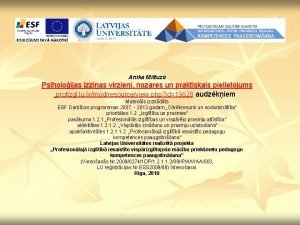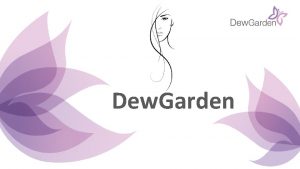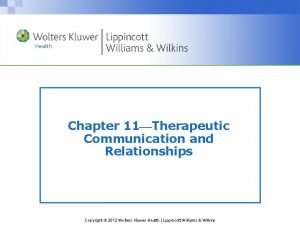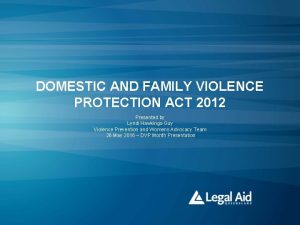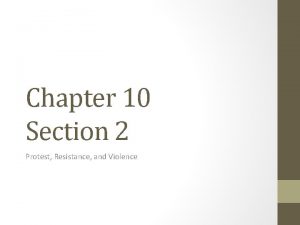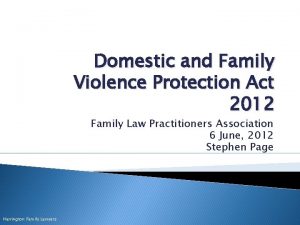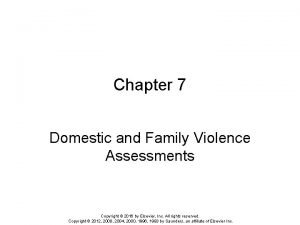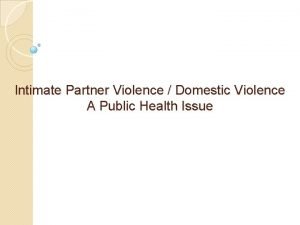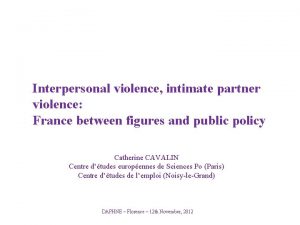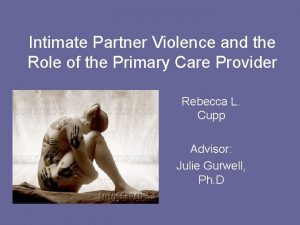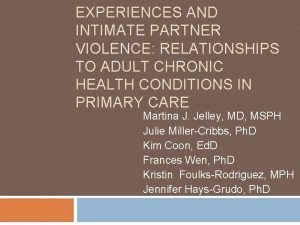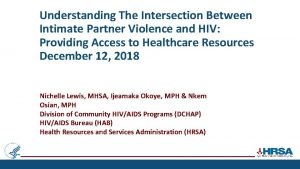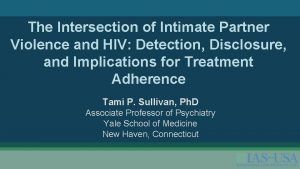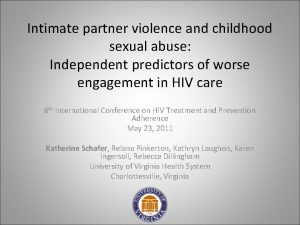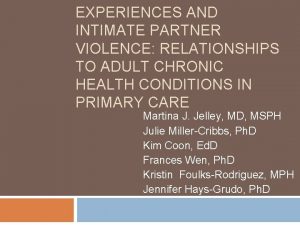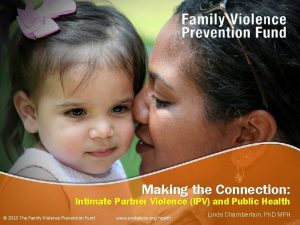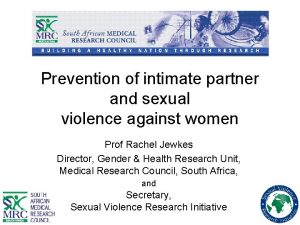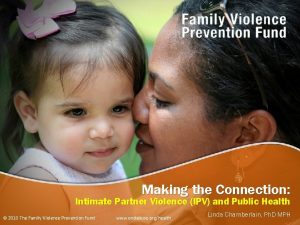Alcohol and Intimate Partner Violence Anika A H


































- Slides: 34

Alcohol and Intimate Partner Violence Anika A. H. Alvanzo, MD, MS Virginia Commonwealth University Medical Center

Introduction • Alcohol Misuse/Alcohol Use Disorders (AUD) – ~16% at risk drinkers; ~ 9% AUD – Cost ~ $185 billion – 3 rd leading cause of death • Intimate Partner Violence (IPV) – 1/4 women and 1/12 men – Cost ~ $6 billion/yr – ~ 1/3 of homicides of women Alcohol Medical Scholars Program, 2 2

This Lecture Will Cover: • Alcohol/IPV – Definition and Epidemiology – Health Consequences – Identification – Treatment – Association between alcohol and IPV – Treatment for co-occurrence Alcohol Medical Scholars Program, 2 3

Alcohol misuse and AUDs Alcohol Medical Scholars Program, 2 4

Alcohol Use Guidelines • Standard drink – 12 oz. beer – 5 oz. of wine – 1. 5 oz. of spirits (hard liquor) • ≤ 2 drinks/day for men • ≤ 1 drink/day for women Alcohol Medical Scholars Program, 2 5

Definitions of Alcohol Use • Heavy/“At-risk” drinking – Men: ≥ 5 drinks/day or ≥ 15 drinks/week – Women: ≥ 4 drinks/day or ≥ 8 drinks/week • Binge drinking – Historically: used for 2+ days drunk – More recently: pattern with BAC ≥ 0. 08% Alcohol Medical Scholars Program, 2 6

Definition of AUD Alcohol dependence ≥ 3 Alcohol abuse ≥ 1 • • Role failure Withdrawal Tolerance Exceed limits Not able to stop/cut down Much time drinking Give up other activities Use despite problems • Risk of bodily harm • Legal problems • Relationships Alcohol Medical Scholars Program, 2 7

Epidemiology of Use and AUD Sex/Age differences: Men Women 18 -24 yo 20% Heavy drinking: 17% 13% 7% 3% 9% Current dependence: 5% 2% 13% Current abuse: Alcohol Medical Scholars Program, 2 8

Epidemiology Racial/Ethnic Differences: Current Heavy Native Am Whites Hispanics Blacks Asians 58% 70% 60% 53% 48% 22% 16% 10% Abuse/ Dependence 12% 9% 8% 7% 4% Alcohol Medical Scholars Program, 2 9

Health Consequences of AUD • GI – Pancreatitis- 10% – Liver diseases • 80% fatty liver • 35% hepatitis • Neuro – Neuropathy- 10% – CBL dysfx- <1% • CV- 20% ↑ mortality • Blood- toxic for blood • Mental Health – Depression • 40% co-occurrence Alcohol Medical Scholars Program, 2 10

Identification of Drinking • Clinical indicators for screening – New patient – Annual exam – ER visit – Pregnancy – Rx medicine that interacts with alcohol – Clinical suspicion • Alcohol on breath • Family member statements Alcohol Medical Scholars Program, 2 11

Screening • NIAAA Clinician’s Guide – # of heavy drinking days in past year • Men: ≥ 5 drinks; women: ≥ 4 drinks – Weekly drinking average • # of drinking days in average week 5 X • # of drinks on average drinking day Weekly average = 4 20 Alcohol Medical Scholars Program, 2 12

Screening • Alcohol Use Disorders Identification Test (AUDIT) – 10 items – + if ≥ 8 for men and ≥ 4 for women • PRIME MD- Patient Health Questionnaire – 5 items – + if ≥ 1 Alcohol Medical Scholars Program, 2 13

Treatment for AUD • Behavioral – Brief Interventions • Pharmacologic – Acamprosate (Campral) • Dose: 2 g/day; 666 mg tid – Cognitive Behavioral Therapy – Disulfiram (Antabuse) • Dose: 250 mg/day – 12 -step programs – Naltrexone (Re. Via) • Dose: 50 -100 mg/day Alcohol Medical Scholars Program, 2 14

Intimate Partner Violence Alcohol Medical Scholars Program, 2 15

Definition of IPV • A pattern of intentionally coercive and assaultive behaviors – Perpetrator is/was/wishes to be an intimate partner – Goal of behavior is to exert control Alcohol Medical Scholars Program, 2 16

Definition of IPV • IPV includes many types of behavior – Physical – Sexual – Psychological/emotional – Stalking – Threats – Property destruction – Neglect Alcohol Medical Scholars Program, 2 17

Epidemiology of IPV • Sex differences: – Women ↑ victims; men ↑perpetrators • Lifetime prevalence: men 8%, women 25% • Women comprised 85% of IPV victims in 1999 • Age differences: – Victimizations: highest prevalence age 20 -24 – Homicides: highest prevalence age 35 -49 Alcohol Medical Scholars Program, 2 18

Epidemiology of IPV • Racial and ethnic differences – African Americans ↑ IPV – Hispanics ↓ IPV non-Hispanics – White women smallest ↓ in IPV homicide Alcohol Medical Scholars Program, 2 19

IPV: Associated Health Effects • ↑ healthcare expenditures • GI – Chronic abdominal pain – Digestive problems • GU – Pelvic pain – Sexually transmitted infections (STI) • Mental Health – Substance misuse – Depression, anxiety, PTSD Alcohol Medical Scholars Program, 2 20

Healthy People 2010: IPV Leading Health Indicators • Access to care • Overweight/Obesity • Environ quality • Physical activity • Immunizations • Sexual behavior • Injury and violence • Substance abuse • Mental health • Tobacco use Alcohol Medical Scholars Program, 2 21

Identification of IPV • Clinical indicators for screening – New patient – Annual exam – Urgent/emergent visit – Pregnancy – Clinical suspicion Alcohol Medical Scholars Program, 2 22

Red Flags for IPV • History clues • Physical exam clues – ↑ somatic complaints – Central injuries – Injury ≠ exam – Defensive wounds – Mental illness – Multiple stages of – Recurrent STIs – Substance misuse healing – Injury in pregnancy Alcohol Medical Scholars Program, 2 23

Identification • Framing statements – “Because violence is so common in our society, I have begun asking all of my patients about it. ” • Indirect questions – “How do you and your partner handle disagreements? ” • Direct questions – “Are you in a relationship with someone who hurts or threatens you? ” Alcohol Medical Scholars Program, 2 24

Abuse Assessment Screen • 5 -item questionnaire • Asks about: – Lifetime physical abuse – Past year physical abuse – Sexual abuse – Abuse during pregnancy • Includes body map Alcohol Medical Scholars Program, 2 25

Abuse Assessment Screen Mark The Area Of Injury On The Body Map Using the Following Scale: 1 = Threats of abuse including use of a weapon 2 = Slapping, pushing; no injuries and/or continuing pain 3 = Punching, kicking, bruises, cuts and/ or continuing pain 4 = Beating up, severe contusions, burns, broken bones 5 = Head injury, internal injury, permanent injury 6 = Use of weapon; wound from weapon Alcohol Medical Scholars Program, 2 26

Danger Assessment Tool • 20 -item questionnaire • Assesses risk for lethality • Factors linked to severe or lethal IPV • Calendar to document assaults Alcohol Medical Scholars Program, 2 27

Interventions • Victims: – Validate disclosure (e. g. show empathy) – Respond to safety concerns – Provide resources • National Hotline 1 -800 -799 -SAFE • Perpetrators: – Batterer intervention programs – Individual counseling Alcohol Medical Scholars Program, 2 28

Alcohol and IPV Victimization • IPV victims ↑ problems with alcohol – 3 x more heavy use – 5% → 16% → 24% with ↑ violence • Women in alcohol treatment ↑ IPV – 87% moderate IPV vs. 28% in community – 40% severe IPV vs. 8% in community • IPV problem drinking Alcohol Medical Scholars Program, 2 29

Alcohol and IPV Perpetration • Men in batterer intervention = ↑ alcohol – Up to 50% have alcohol problem – ↑ violence on heavy drinking days • Men in alcohol treatment = ↑ IPV – Prevalence ~ 50% Alcohol Medical Scholars Program, 2 30

Trauma/SUD Interventions • Seeking Safety – Group behavioral intervention – PTSD and SUD – ↓ PTSD symptoms and substance use • Trauma Recovery Empowerment Model – Group behavioral intervention – Hx trauma and mental illness – ↓ trauma symptoms and substance use Alcohol Medical Scholars Program, 2 31

Treatment of AUD and IPV • Perpetration – Few studies ↓ IPV after alcohol Rx – Only 1 study of integrated therapy • + effect on alcohol & IPV post-treatment • No difference at 6 month f/u Alcohol Medical Scholars Program, 2 32

Summary • Alcohol misuse + IPV = major public health problems • Alcohol misuse + IPV commonly co-occur • Should routinely ask about both – Ask about both in routine clinical encounter – Screen for IPV in addiction treatment settings – Screen for alcohol misuse in settings serving victims of IPV • More research is needed Alcohol Medical Scholars Program, 2 33

Questions Alcohol Medical Scholars Program, 2 34
 The spyware used in intimate partner violence
The spyware used in intimate partner violence Konj pipi duga carapa
Konj pipi duga carapa Anika lane
Anika lane Anika miltuze
Anika miltuze Anika mirza
Anika mirza Anika bergen
Anika bergen Secondary alcohols
Secondary alcohols Primary alcohol secondary alcohol
Primary alcohol secondary alcohol Intimate relationships, marriages, and families 9th edition
Intimate relationships, marriages, and families 9th edition Define the relationship ch 7
Define the relationship ch 7 Sternberg love types
Sternberg love types Intimate distance is:
Intimate distance is: Intimate family chapter 6
Intimate family chapter 6 Intimate family chapter 6
Intimate family chapter 6 The essence of marriage chapter 2
The essence of marriage chapter 2 Intimate family chapter 2
Intimate family chapter 2 Intimate language register
Intimate language register Dewgarden foaming intimate wash benefits
Dewgarden foaming intimate wash benefits Intimate zone in communication
Intimate zone in communication Intimate zone in communication
Intimate zone in communication Relaxed antonym
Relaxed antonym 01 me line intimate
01 me line intimate Abcde of intimate relationship
Abcde of intimate relationship Intimacy after incarceration
Intimacy after incarceration Different modifiers of human acts
Different modifiers of human acts Domestic and family violence protection act 2012
Domestic and family violence protection act 2012 Gandhi king and mandela what made non-violence work dbq
Gandhi king and mandela what made non-violence work dbq Chapter 9 lesson 2 resolving conflicts
Chapter 9 lesson 2 resolving conflicts Chapter 27 anger aggression and violence
Chapter 27 anger aggression and violence Chapter 10 section 2 protest resistance and violence
Chapter 10 section 2 protest resistance and violence Domestic and family violence protection act 2012
Domestic and family violence protection act 2012 Chapter 9 resolving conflicts and preventing violence
Chapter 9 resolving conflicts and preventing violence Ebb tide tackle
Ebb tide tackle Framework agreement on harassment and violence at work
Framework agreement on harassment and violence at work Chapter 7 domestic and family violence assessment
Chapter 7 domestic and family violence assessment



